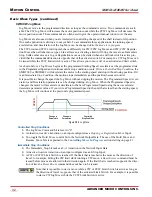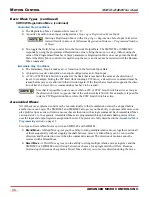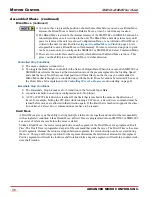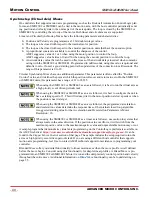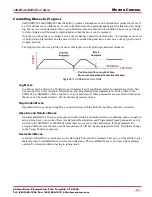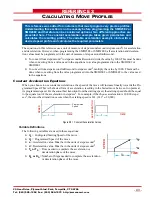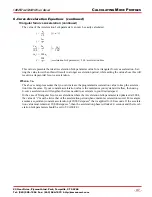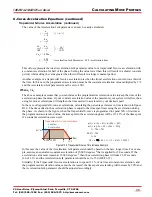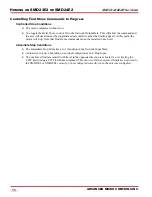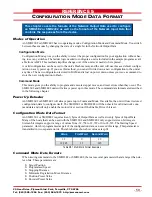
C
ALCULATING
M
OVE
P
ROFILES
SMD23E2 and SMD24E2 User’s Manual
ADVANCED MICRO CONTROLS INC.
46
S-Curve Acceleration Equations
When the Acceleration Jerk parameter value is in the range of 1 to 5,000, the SMD23E2 and SMD24E2 uses
this value to smoothly change the acceleration value applied during the move. In this case, the speed of the
move does not increase linearly, but exponentially, resulting in an “S” shaped curve. This limits mechanical
shocks to the system as the load accelerates. Just as constant acceleration will result in a trapezoidal or trian-
gular speed profile, the Acceleration Jerk parameter will result in a trapezoidal or triangular acceleration
phase.
In order to keep the Acceleration Jerk parameter value that is programmed into the SMD23E2 or SMD24E2
below sixteen bits, the Acceleration Jerk parameter programmed into the driver does not have units of steps/
sec
3
. The Acceleration Jerk parameter equals ({100 * jerk in steps/sec
3
} / acceleration in steps/sec
2
). This
translates to the jerk property in steps/sec
3
equalling ({Acceleration Jerk parameter/100} * acceleration in
steps/sec
2
). With the range of values for the Acceleration Jerk parameter being 1 to 5,000, the jerk value
ranges from 0.01
a
to 50
a
where “
a
” is the acceleration value in steps/sec
2
. For example, if the acceleration is
programmed to 20,000 steps/sec
2
, then the value of the jerk property used by the unit can be programmed to
be between 200 steps/sec
3
(0.01*20,000) and 1,000,000 steps/sec
3
(50*20,000). This statement applies to the
Deceleration Parameter as well. If the Acceleration and Deceleration parameters are different, the calculated
jerk values will also differ.
When using variable accelerations, the starting speed does not have to be equal to the square root of the pro-
grammed acceleration value. Variable acceleration provides smooth transitions at the beginning and end of
the acceleration phase.
Triangular S-Curve Acceleration
Figure R3.2 shows the speed profile of a move during its acceleration phase. The figure shows the desired tri-
angular S-curve acceleration in red along with the equivalent constant acceleration in blue. The equivalent
constant acceleration is equal to the change in speed divided by the time it takes to achieve this change in
speed. This is the value that would have to be used if the Jerk parameter was left at zero and we will use this
information to calculate the S-curve acceleration and the value of the Jerk Parameter.
Figure R3.2 Move Profile Example
Speed is equal to acceleration multiplied by the time it is applied.
This is shown graphically in figure R3.3 as the area of the blue
rectangle. In order for the Triangular S-curve acceleration to reach
the same speed in the same amount of time, the area of the triangle
must equal the area of the square. Area of a triangle is one half of
the base length multiplied by the height. Therefore:
This means that a triangular S-curve acceleration profile requires
twice the programmed maximum acceleration as a constant accel-
eration profile to achieve the same speed in the same amount of
time.
Sp
e
e
d
Programmed
Speed
Starting
Speed
s = Programmed Speed – Starting Speed
s
t
t=0
Time
Constant
Acceleration
Triangular S-Curve
Acceleration
Acceleration =
a
=
j
=
j
=
jerk =
Jerk Parameter(J) =
SMD
Acceleration
speed
time
s
t
a
t
Ja
100
acceleration
time
100j
a
Ac
ce
le
ra
ti
o
n
t
a
c
a
s
Time
Constant
Acceleration
Triangular S-Curve
Acceleration
t/2
Figure R3.3 Triangular Acceleration
a
c
t
a
s
t
2
------- Area of rectangle = Area of triangle
=
a
s
2
a
c
=

